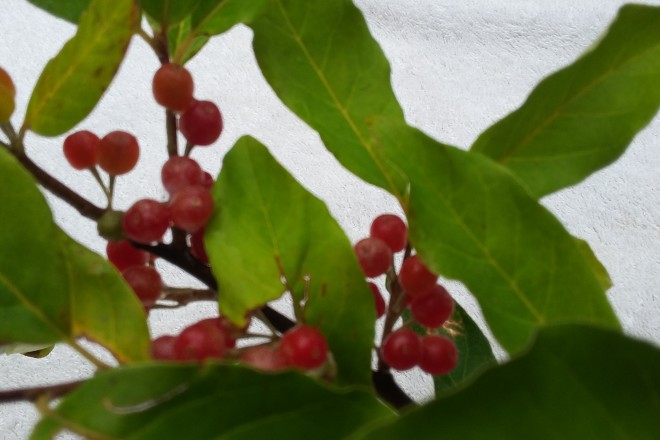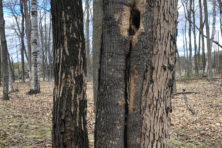Going Native: Another Invasive, Another Task
- Share
- Tweet
- Pin
- Share

By Peter Sigmann
Natural landscaping with native plants does away with some of the conventional chores such as watering, fertilizing and chemical treatments, but this style of gardening presents other tasks such as transplanting, thinning and the removal of undesirable or invasive plants. The first step of clearing a lawn surface for natural landscaping is to stop mowing. If there is a tree overhead tiny “trees” may emerge within a couple of weeks. Chances are high that they will have lance-shaped leaves that are thin and have a wavy margin. They are a healthy green on top and shiny silvery on the underside. When pulling such a plant out of the soil it becomes apparent that the roots are substantial and woody. They may have been in place for years and kept undetected by mowing.
The plant in question is Autumn Olive. It was introduced from East Asia as a food plant for wildlife but has become widely invasive in the Midwest and is spreading on the Door Peninsula.
The mature plant is an asymmetric multi-stemmed shrub or tree that can reach a height of 20 feet. The leaves are attached alternating on a grey stem and red-brown branches. The flowers are inconspicuous but intensely fragrant. A heavy amount of berries is attached to twigs and leaf axils. When ripe they are an attractive red color and ¼-inch in size. The pulp tastes pleasantly sweet and is said to contain health-promoting ingredients. A single seed resides in the center.
Birds swallow the berries, digest the pulp and expel the seeds from their perches in trees high and low. Seedlings sprout from the seeds where there is light and no competing broadleaf vegetation. A common sight is a Hawthorne or old apple tree growing on a dry field in the company of one or more Autumn Olive shrubs. A septic mound under tall oak trees became host to about 100 Autumn Olive seedlings after the owner decided to forego mowing.
Autumn Olive is controllable by regular mowing. Where a lawn is not desired the seedlings must be pulled. Pliers can help with pulling. Once the ground is covered by broadleaf vegetation no new seedlings will emerge. Cutting the seed-producing shrubs and treating the cut stem with herbicide provides control on a neighborhood level and is necessary to maintain the integrity of protected natural areas.
When controlling Autumn Olive it is necessary not to do harm to a desirable native shrub, Canada Buffaloberry. It shares some its characteristics, having pretty red berries that are spread by birds. The underside of the leaves also is silvery, but not shiny and not smooth. The leaf attachments are opposite, not alternate. The leaves are also thicker and wider. Buffaloberry is not invasive and belongs in a harmonious native landscape. Nurturing desirable plants is another example of tasks in natural landscaping.
 “Going Native” is an occasional series from the Door County Chapter of Wild Ones. Wild Ones: Native Plants, Natural Landscapes promotes environmentally sound practices to encourage biodiversity through the preservation, restoration and establishment of native plant communities. The Door County chapter of Wild Ones aims to share knowledge and experience in natural landscaping by means of nature walks, yard visits and lectures. For more information visit wildones.org.
“Going Native” is an occasional series from the Door County Chapter of Wild Ones. Wild Ones: Native Plants, Natural Landscapes promotes environmentally sound practices to encourage biodiversity through the preservation, restoration and establishment of native plant communities. The Door County chapter of Wild Ones aims to share knowledge and experience in natural landscaping by means of nature walks, yard visits and lectures. For more information visit wildones.org.



